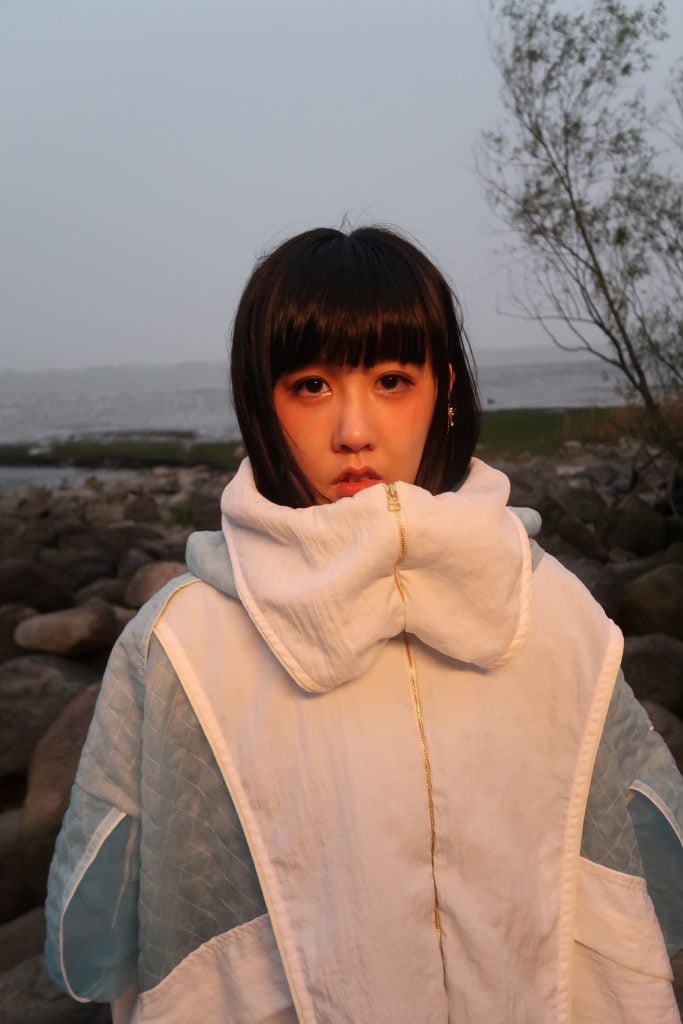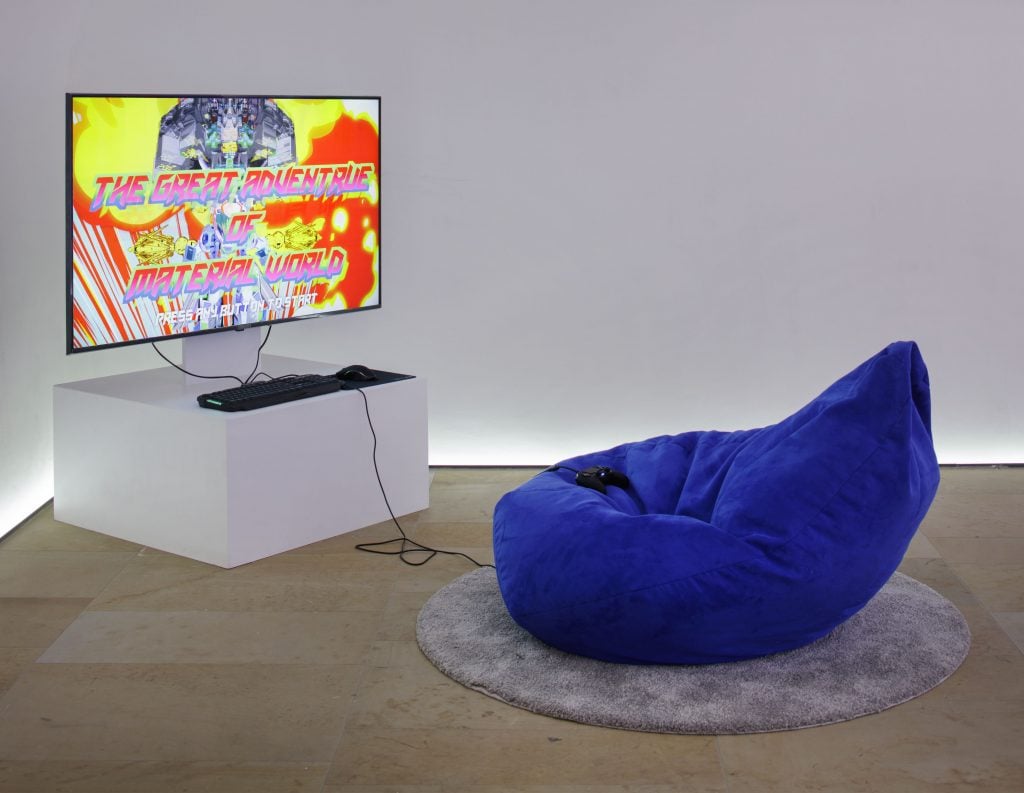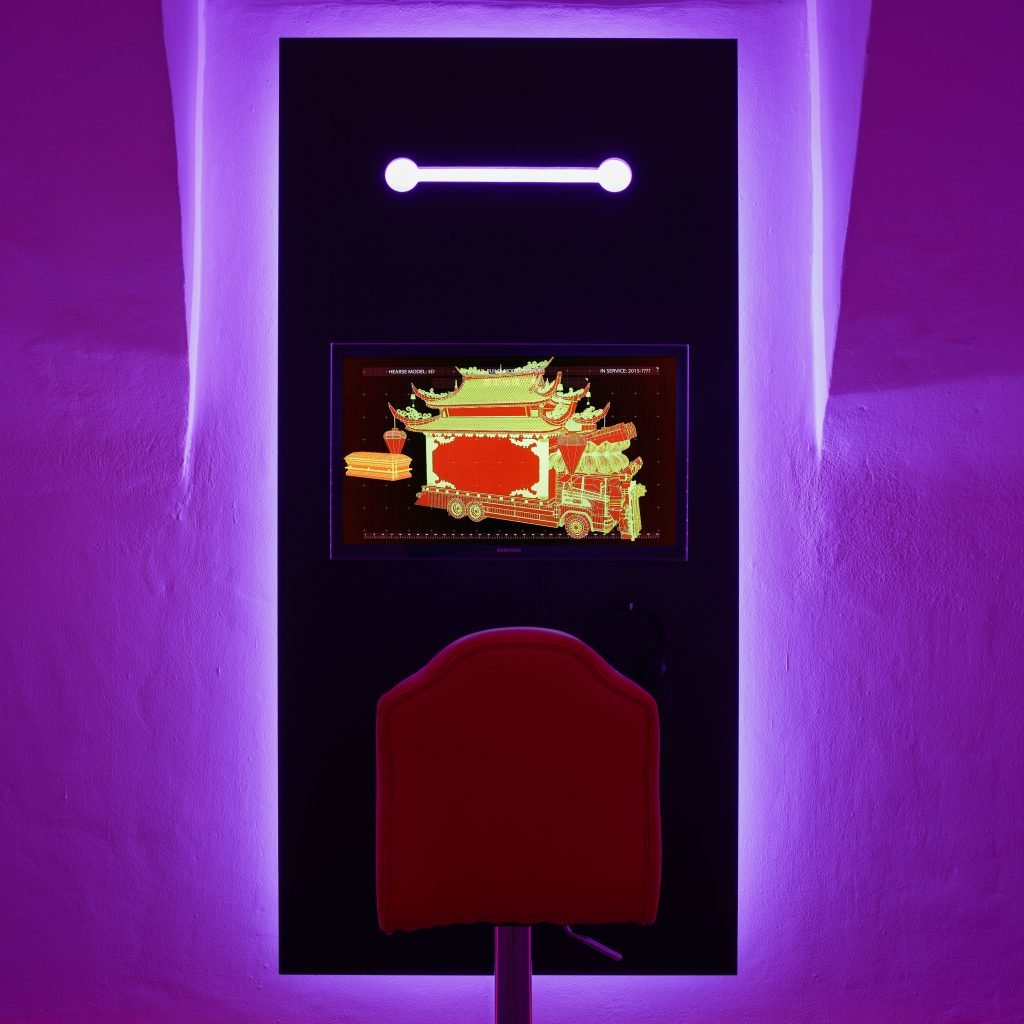People
‘I Felt the Lightning Right Next to Me’: Artist Lu Yang on How a Harrowing Flight Experience Led to a Breakthrough Digital Artwork
We also spoke with the digital artist about what avatars can and cannot do.

We also spoke with the digital artist about what avatars can and cannot do.

Hili Perlson

Lu Yang’s visionary digital work, which fuses ancient mythologies with bleeding-edge technology and boundary-pushing concepts borrowed from developments in human biology, has gained the Shanghai-based artist an enthusiastic following across Asia in the past decade-plus. Experienced mostly on screens, his works are populated by muscular demigods, prancing tumor cells, and even a superhero called uterus man who glides about on a turbo-powered sanitary slip.
It has taken Western audiences a bit longer to respond. But now, after being included in institutional group shows across Europe—sometimes themed around topics like posthumanism—the artist has doubtlessly arrived on the continent in full force.
This year opened with a major solo exhibition at the ARoS museum in Aarhus, Denmark, closely followed by an exhibition at the Kunstpalais in Erlangen, Germany. He has been named the 2022 Deutsche Bank artist of the Year, a distinction that comes with a solo exhibition at the bank’s private Berlin museum, the Palais Populaire, in September. The artist is also included in the main exhibition of the current Venice Biennale with an otherworldly CGI-saga featuring the artist’s avatar, DOKU.
“Lu Yang opens up a range of possibilities to connect spirituality and technology,” curators Nora Gantert and Malte Lin-Kröger, who organized the exhibition in Erlangen, said in a statement. This, they argue, “resonates well with current underlying societal insecurities that are caused by being faced with new technologies that go beyond our understanding.”
On the occasion of the presentations, we spoke to Lu Yang about identity, what digital avatars can and cannot do, and how a revelatory 2020 flight fundamentally changed his perspective.

Lu Yang, The Great Adventure of Material World game (2019). © Lu Yang, installation view LuYang. False Awakening, 2022, Kunstpalais, Erlangen, photo: Ludger Paffrath
Your works often delve into themes concerning the body on an organic level: the DNA of living matter, its function, reproduction, but also disease, death, and decay. Why are you drawn to such topics?
I am naturally interested in macro-level dimensions, and I hope my work has a broader horizon of exploration. Topics such as our lives, desires, and the limitations and functions of our bodies are relevant to every living person. This allows me to go beyond the limits of my identity to think freely on a higher level, in a larger universe. Any human being can understand my works. They don’t need any specific political, historical, or cultural knowledge or background to enter my works, because these topics confront the human condition.
Since you brought up the idea of transcending the limits of your identity, I’d like to ask you about labels. In many earlier articles about your art, journalists and critics discuss your gender, your appearance, even the pitch of your voice. Does your decision to go by male pronouns have to do with such reactions to your artistic practice?
I wouldn’t want to be confined by my national identity, and even less so by my gender identity. I feel that I am only a conscious being in the universe. But the media tend to fuss over my female body. Sometimes they simply attribute anything—even whether I am successful or not—to my gender. For example, certain male curators asked me directly, “Do you think you got the opportunities because you’re a woman?” Therefore sometimes I use the pronoun he/him.
I rarely socialize in artistic circles. I try my best to maintain my way as a creative artist who gets into contact with the outside world only through artistic works. When I’m working alone, I feel extremely free: because of deep concentration, because of not being measured by all kinds of social parameters. When I face society, I have no choice but to be labeled. Since I cannot prevent the outside world from defining me, I must disguise myself with a gendered mask to engage in normal interpersonal communication. Yet deep down I’m totally indifferent to all this.

Lu Yang, Delusional Mandala (2016). © Lu Yang, installation view LuYang. False Awakening, 2022, Kunstpalais, Erlangen, photo: Ludger Paffrath
Your own avatar—a genderless humanoid that slightly resembles you—often also appears in your work. Is a digital presence your vehicle for evading labeling?
Indeed, a digital body seems much easier to use than a physical one. You can change what we conceive as human features in the digital body at will: shape, gender, appearance. Nor does the digital body have the problems of sickness and lifespan. A digital body is surely more convenient and easier to use than the physical body I have now. Yet I still feel that digital avatars are only projections of our concepts and consciousness. We still think we must have a body, in the real or the virtual world, and we still think this body in the virtual world should have a shape that we recognize, of an upright creature affected by gravity and walking on two legs. On this level of consciousness, there is no essential difference between the physical body and the digital body, for both are restricted by our conception.
The title of your current solo exhibition, “False Awakening,” describes the phenomenon in which a person dreams they’re awake and performing daily tasks when in fact they’re asleep. What significance does the title have in relation to the experience of the exhibition?
“False Awakening” incorporates, to a large extent, my own worldview, living condition, and the ideas and moods of my works. I feel there is no binary opposition between truth and false, dream and reality in this world. Our modern society has experienced fast-moving scientific and technological developments. It seems to be awake yet also asleep; human wisdom, when compared with that in the earlier stages of human history, appears still dormant. This world is like a dream in a dream, in which time, space, and consciousness intersect.

Lu Yang, Delusional world game (preview) (2022). © Lu Yang, installation view LuYang. False Awakening, 2022, Kunstpalais, Erlangen, photo: Ludger Paffrath
A new work featuring your avatar, titled DOKU—the self, is included in the 59th Venice Biennale. What can you tell me about it?
The work starts with DOKU’s dream, when he and others are trying to escape calamity. His dream feels so real that the moment he experiences death in it he wakes up, only to find himself on an airplane as a human being, ready to embark on his travels. Dying in a dream and coming back to life in reality—I often experience this personally, which makes me think that life and death are separated only by a door. In 2020 I had a flight experience in which I felt a wonderful ecstasy so strong that it still impacts every moment of my present. The plane flew through a thunderstorm. I saw lightning near and far, forming a vertical angle to the city. The airplane was moving up and down in thunder and heavy rain. I felt the lightning right next to me, appearing and disappearing in the clouds. Other passengers panicked or screamed, but I looked out the window, amazed. I experienced ecstasy, observing as both the subject and the object. Time was still, or there was no time at all. Space appeared to no longer be what I used to conceptualize it as.
I was quite depressed due to Covid, but this experience, which produced a lasting ecstasy in me, allowed me to see the world in a totally new way. It was so wonderful that I wanted to know more, so I searched online to see whether others had similar experiences. And I found that what I felt is very similar to the so-called “overview effect,” even though it is usually experienced by astronauts in the much more distant universe.
DOKU experiences the overview effect in my stead on the plane in the digital world. When I was creating this work, I could always return to that airplane and to the starting point at which I experienced the ecstasy. This work contains so much philosophical thinking that I can hardly describe it with language. But I think the origin of this work is very important. Although it sounds a little mysterious, I am convinced that I should first share this story to help you understand this piece of work.
“False Awakening” runs through June 19, 2022, at Kunstpalais, Erlangen, Germany. A long version of this interview appears in the show’s exhibition catalogue.
Lu Yang’s solo exhibition as Deutsche Bank Artist of the Year 2022 opens on September 15 at PalaisPopulaire, Berlin, Germany.